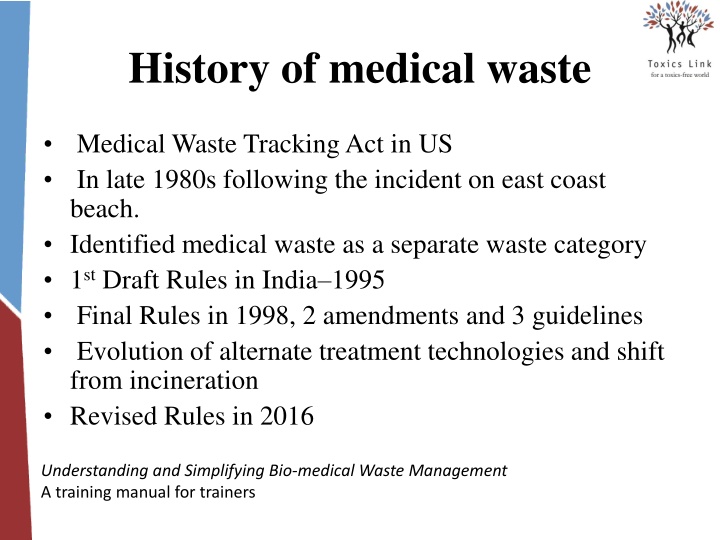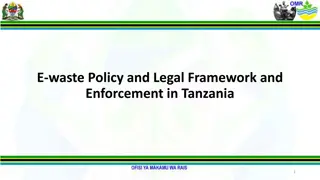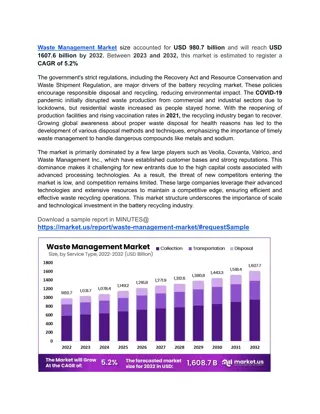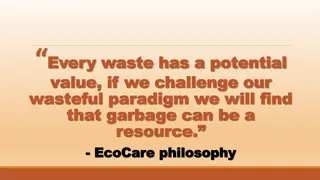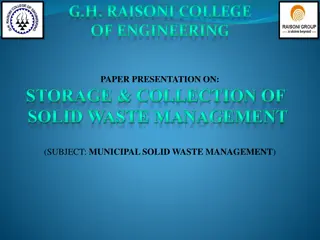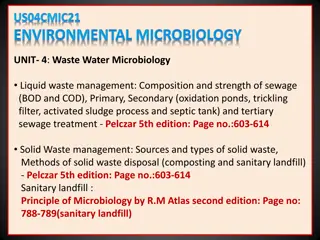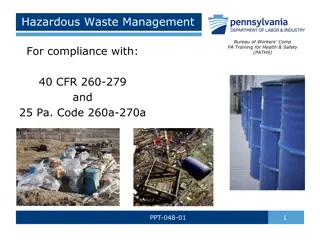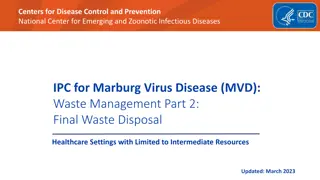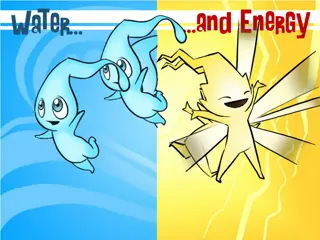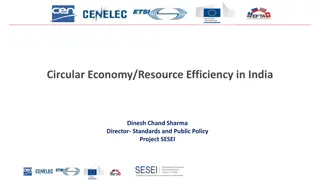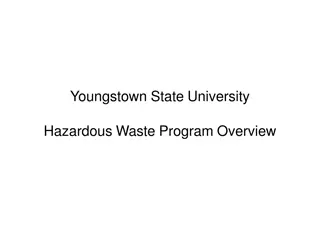Evolution of Medical Waste Management and Regulations in Healthcare
Medical waste management has evolved over the years, with the introduction of regulations like the Medical Waste Tracking Act in the US and the implementation of rules and guidelines in India. Various networks and organizations are involved in promoting safe waste disposal practices. The concern for infectious waste, including sharps, pharmaceuticals, and radioactive materials, highlights the importance of proper management to protect public health. Infectious waste poses risks to healthcare workers, patients, and the community at large, emphasizing the need for strict protocols and training.
Download Presentation

Please find below an Image/Link to download the presentation.
The content on the website is provided AS IS for your information and personal use only. It may not be sold, licensed, or shared on other websites without obtaining consent from the author.If you encounter any issues during the download, it is possible that the publisher has removed the file from their server.
You are allowed to download the files provided on this website for personal or commercial use, subject to the condition that they are used lawfully. All files are the property of their respective owners.
The content on the website is provided AS IS for your information and personal use only. It may not be sold, licensed, or shared on other websites without obtaining consent from the author.
E N D
Presentation Transcript
History of medical waste Medical Waste Tracking Act in US In late 1980s following the incident on east coast beach. Identified medical waste as a separate waste category 1stDraft Rules in India 1995 Final Rules in 1998, 2 amendments and 3 guidelines Evolution of alternate treatment technologies and shift from incineration Revised Rules in 2016 Understanding and Simplifying Bio-medical Waste Management A training manual for trainers
Various networks NGOs Healthcare Without Harm (HWCH) Hu-MAN Injection safety: SIGN (Safe Injection Global Network) Anti-incineration: GAIA (Global Anti Incineration Alliance) Alternatives Understanding and Simplifying Bio-medical Waste Management A training manual for trainers
What is this concern for? Infectious waste (solid and liquid) Sharps waste Cytotoxic waste Pharmaceutical waste Radioactive waste Chemicals and disinfectants Pressurised containers Mercury equipments Understanding and Simplifying Bio-medical Waste Management A training manual for trainers
Know your waste 80 70 60 50 40 30 20 10 0 Infectios Hazardous General Understanding and Simplifying Bio-medical Waste Management A training manual for trainers
Impacts of hospital waste Impacts entire community Population at greatest risk oPatients o Healthcare workers o Municipal workers o Rag pickers o Workers at recycling industries, waste treatment facilities Understanding and Simplifying Bio-medical Waste Management A training manual for trainers
What is infectious waste? Items saturated with blood Sharps (used and unused) Cultures and stocks Animal waste, bedding and carcasses in contact with infectious agents Wastes from patients with certain highly contagious diseases Understanding and Simplifying Bio-medical Waste Management A training manual for trainers
Concerns in infectious waste Blood borne pathogens Body fluids acting as transmission vehicles to various pathogens Presence of resistant strains Presence of concentrated cultures of pathogens Invasive sharps waste Understanding and Simplifying Bio-medical Waste Management A training manual for trainers
Modes of transmission of infections Direct physical contact of host and agent through untreated culture and stocks, body fluid spills Generation of aerosol during treatment of waste like shredding, chemical disinfection; untreated waste Vehicle borne transmission, needle sticks, splashes of body fluids on clothes, contact with contaminated material Understanding and Simplifying Bio-medical Waste Management A training manual for trainers
All it needs to transmit infections Medical waste has everything needed for disease transmission: Presence of an infectious agent Sufficient concentration of the agent to cause an infection Portal of entry of infectious agent to the host Mode of transmission of agent to the host Understanding and Simplifying Bio-medical Waste Management A training manual for trainers
Why wear protective gear To avoid: Prick injuries Blood splashes during waste handling Aerosolized pathogens during loading, compaction/ shredding or spillage of waste Spills Chemical exposure Understanding and Simplifying Bio-medical Waste Management A training manual for trainers
What are sharps? Anything capable of causing cuts and punctures: Needles Blades Scalpels Lancets Sutures I.V. catheters Broken glass, ampoules Understanding and Simplifying Bio-medical Waste Management A training manual for trainers
Sero-conversion following exposure Pathogen Conversion rate Conversion time HIV HBV HCV 0.3% 30% 10% 6 months 2-6 months 7 weeks Understanding and Simplifying Bio-medical Waste Management A training manual for trainers
Reported cases of transmission In 1994, 39 cases of HIV infection were recognised by CDC, USA, as occupational infections, with the following path of transmission: 32 from hypodermic needle injuries 1 from blade, broken glass and contact with non-sharp infectious item 4 from exposure of skin or mucous membrane to infected blood By 1996, such cases had risen to 51. All cases were nurse, medical doctors, or laboratory assistants Understanding and Simplifying Bio-medical Waste Management A training manual for trainers
Reported cases of transmission France: In 1992, eight cases of HIV infection were recognized as occupational infections. Two of these occurred through wounds in waste handlers Understanding and Simplifying Bio-medical Waste Management A training manual for trainers
Reuse Worldwide, 8-16 million hepatitis B, 2.3-4.7 million hepatitis C and 80,000-1,60,000 HIV infections are estimated to occur yearly from needles without sterilization. The prevalence of re-use varies but estimates range between 15-40%. Some estimates exceed 50%. Re-use is common in all poor countries. re-use of syringe Understanding and Simplifying Bio-medical Waste Management A training manual for trainers
Administering injections/ infections Over 30 % of the 12 billion injections given worldwide each year are administered unsafely Reusable syringes are not properly sterilized before use Disposable syringes are used more than once Used syringes are not disposed of properly According to a WHO report, HBV can survive in a syringe, in dry conditions for 7-8 days Understanding and Simplifying Bio-medical Waste Management A training manual for trainers
Infection through body fluids Pathology Gastro enteric infections Respiratory infections Ocular infections Genital infections Skin infections Anthrax Meningitis AIDS Haemorrhagic fevers Septicaemia Bacteraemia Candidaemia Hepatitis A Hepatitis B&C Understanding and Simplifying Bio-medical Waste Management A training manual for trainers Infected Body fluid Faeces and/or vomiting Breathing secretions, saliva Eye secretions Genital secretions Pus Skin secretions Cerebrospinal fluid Blood, sexual secretions All blood products & secretions Blood Blood Blood Faeces Blood and body fluids
Other exposures Vaccine waste Radioactive waste Chemical waste Hazardous chemicals o Cytotoxic drugs o Mercury o Glutaraldehyde/cidex Understanding and Simplifying Bio-medical Waste Management A training manual for trainers
Exposure hazards Vaccine waste Radioactive waste Six children diagnosed with small pox, June 2000 Four people died from acute radiation syndrome and 28 suffered serious radiation burns Brazil, 1988 Six children were diagnosed with a mild form of small pox (vaccinia virus) after having played with glass ampoules containing expired vaccine at a garbage dump in Vladivostok (Russia) Of 249 people exposed to a sealed radioactive source, several either died or suffered severe health problems small pox Understanding and Simplifying Bio-medical Waste Management A training manual for trainers
Chemicals Disinfectants Photographic chemicals Solvents Organic chemicals Inorganic chemicals Understanding and Simplifying Bio-medical Waste Management A training manual for trainers
Cytotoxic drugs Used in cancer treatment Short term effects: skin injury, light headedness, dizziness, nausea, headache, and allergic reactions. Long term effects: some anti-neoplastics are carcinogens. They may also cause birth defect (teratogens) and miscarriages, as well as chromosomal damage (mutagens). Understanding and Simplifying Bio-medical Waste Management A training manual for trainers
Mercury Used in various medical equipment, dental amalgams, etc Damage to the brain, the kidneys and developing foetus. Effects on brain functioning may result in irritability, shyness, tremors, changes in vision or hearing, and memory problems In addition, short-term exposure to high levels of metallic mercury vapours may cause effects including lung damage, nausea, vomiting, diarrohea, increases in blood pressure or heart rate, skin rashes, and eye irritation Understanding and Simplifying Bio-medical Waste Management A training manual for trainers
Glutaraldehyde Used as a disinfectant Irritates skin, eyes, throat and lungs, causes sensitization of skin and respiratory tract Can cause allergic reaction, like asthma Skin sensitization and contact dermatitis Headache, shortness of breath, chest pain, discomfort, cough and fatigue Understanding and Simplifying Bio-medical Waste Management A training manual for trainers
Salient features of the rules Applies to anyone who generates / treats / collects bio- medical waste Segregation, disinfection and mutilation of waste No storage of untreated waste beyond 48 hrs No incineration of chlorinated plastics, no chemical pretreatment before incineration Phase out of Chlorinated plastics Proper labeling, weighing and bar coding of waste Understanding and Simplifying Bio-medical Waste Management A training manual for trainers
Salient features of the rules Municipal authorities to pick up general waste Centralized Bio medical treatment facilities to pick up Bio medical waste Microbiological and Biotechnological waste should be pre treated before handling over to CBWTF Strict standards for incinerators Penalty as under EPA Understanding and Simplifying Bio-medical Waste Management A training manual for trainers
Rules Environment Protection Act, 1986 Solid Waste Management Rules, 2016 Atomic Energy Act Hazardous Waste (Management and Handling) Rules, 1989 E-Waste Rules, 2016 Understanding and Simplifying Bio-medical Waste Management A training manual for trainers
